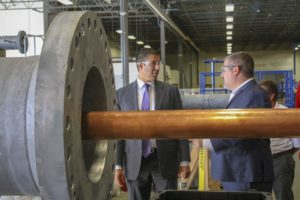Dielectric Meeting with FCC Addresses Potential Repack Phase Completion Issues
Winter weather delays, tower rigging crew shortages among top issues driving concerns over successful completion of repack transitions; Dielectric to demonstrate auxiliary antenna solution at NAB
RAYMOND, Maine, February 19, 2019 — Dielectric, along with other broadcast representatives, attended a January 31 meeting with the FCC Incentive Auction Task Force and Media Bureau to provide an update on repack site completions. The meeting followed an October 2018 meeting at which Dielectric presented data indicating tower crew concerns about timely completion of main antenna installations.

The output from the FCC meeting was clear: “The FCC will be flexible in considering STA applications, and extensions if justified, potentially allowing more stations to use interim antennas to meet phase deadlines,” said Keith Pelletier, vice president and general manager, Dielectric.
Although significant repack progress has been made, there are signs that broadcasters may face increasing difficulty in meeting phase deadlines due to severe winter weather and a shortage of qualified tower crews. As rigging and other delays build, Dielectric sees the potential for a domino effect, delaying installations of permanent antennas.
“Some of our customers have been forced to place their permanent repack antennas in storage,” said Pelletier. “Stations that fail to vacate their channels in time could prevent stations in future phases from staying on schedule, due to the critical linked changes in the transition plan. We see potential for a serious bottleneck in phases 3 through 6.”
The installation of interim antennas could keep channel phase evacuations and associated linked changes on track. Although this is not a one size fits all solution, there are many more rigging crews capable of safely installing these side-mount broadband antennas.
“The FCC has indicated their willingness to approve interim facilities for reimbursement with suitable engineering support, demonstrating that the interim facility does not significantly harm the station’s over-the-air viewership,” said Jay Martin, VP Sales, Dielectric. “If the choice becomes going off-air or staying on the existing channel and disrupting critical linkages, operating an interim facility may be a viable compromise for all concerned.”
Making an Interim Plan
Dielectric updated its entire TV antenna product line over the past several years in preparation for repack. The company also foresaw the challenges of the industry adhering to a strict transition schedule of 10 phases in 39 months — directly leading to the creation of its TFU-WB Series antenna in 2016.
The TFU-WB Series is a flexible, broadband antenna, available in horizontally and elliptically polarized versions. Marketed as a main or auxiliary antenna, the TFU-WB offers an interim side-mounted solution for stations challenged by rigging, permitting or other delays. This year marks the third anniversary of its first use broadcasting ATSC 3.0 signals over Las Vegas. It will continue to be a focal point at Dielectric’s NAB Show 2019 booth (C2213) as it serves a critical industry need. NAB Show 2019 show takes place April 8-11 at the Las Vegas Convention Center.
“TV stations and their consultants should critically evaluate their progress towards meeting phase deadlines now and, where appropriate, seek approval to use and install interim antennas,” said Pelletier. “The TFU-WB exists to help stations vacate their existing channels on time — the chief goal of the repack—by staying on the air, operating under STA rules, until their permanent antennas are installed.
No Time to Waste
Nearly 143 affected stations moved during phase 1, which ended November 30, 2018, with another 115 phase 2 stations scheduled to move to new channels by April 12. While the first phase progressed relatively close to schedule, more than 30 stations are now operating under STA approvals.
“The FCC’s stated willingness to be flexible with stations experiencing difficulties and considering interim facilitieswill be essential,” said Martin. “More than 400 more stations must move to new channels in phases 3 through 6 between mid-April and October 18th.”
“The broadband design of these antennas means that Dielectric can have antennas on hand for quick deployment,but it is important for stations to work with their consultants now to identify whether the interim antenna is a suitable solution,” said Pelletier. “Dielectric is firmly committed to working with the FCC and helping broadcasters meet their repack deadlines, thus freeing spectrum for Incentive Auction winners.”
About Dielectric
Based in Raymond, Maine, Dielectric LLC is a wholly owned subsidiary of Sinclair Broadcast Group. Dielectric is a leading provider of innovative broadcast products. Now celebrating its 76th year of operation, the company builds and delivers antennas and RF systems optimized for every TV and FM radio broadcast need since 1942. Dielectric is an innovative, customer-centric organization with a long history of engineering excellence in designing and manufacturing high-quality broadcast solutions. As a trust partner of broadcasters worldwide, Dielectric maintains its legacy of advanced, precision RF solutions while building in features that prepare broadcasters for the future. More information can be accessed at www.dielectric.com